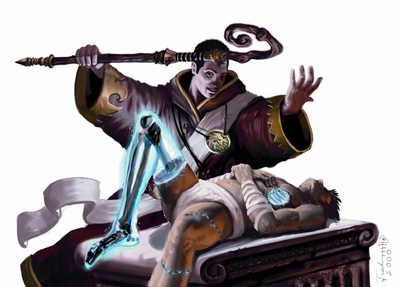Resurrection
(Necromantic)
Reversible: Destruction

Reversible: Destruction
Resurrection
(Necromantic)
Reversible: Destruction

Reversible: Destruction
|
|
|
|
|
|
|
|
|
|
|
|
|
|
|
|
|
|
Effect: The cleric employing this spell is able to restore life and complete (strength) to the person he/she bestows the resurrection upon.
The person can have been
dead up to 10 years cumulative per level of the cleric casting the spell,
i.e. a 19th level cleric
can resurrect the bones of a person dead up to 190 years.
See raise
dead for limitations on what persons can be raised.
Employment of this spell
makes it impossible for the cleric to cast further
spells or engage in
combat until he || she has
had one day of bed rest for each level of experience of the person brought
back to life or destroyed.

The reverse,
destruction,
causes the victim of the
spell to be instantly dead and turned to dust.
Destruction requires a touch,
either in combat
or otherwise.
MC: The cleric's religious
symbol
and holy/unholy water.
Shukenja:
The shukenja employing this spell is able to restore life and complete
health to a dead body.
The body may be dead up
to 10 years per level of the shukenja, but must also be in a relatively
complete form.
The character being resurrected
must be an honorable creature, as the spell does not function on those
of less than 50 honor.
Casting this spell is so
draining that the caster must REST in bed for one day for each level of
experience of the figure brought back to life, and may cast no further
spells during that time.
Shukenja.Destruction: The spell's reverse, destruction, turns the victim to dust, and requires the shukenja to touch the victim.
Shukenja.MC: Components
of both spells are the shukenja's holy
symbol, holy water, and burning
incense tapers.
Question: Does the
spell Resurrection require a Constitution
percentage roll?
If so, does the character
lose a point from his Constitution?
Answer:  ,
to both.
,
to both.
However, some DMs donít
make you lose the point.
They only want you to keep
track of how many times you have raised, and once you have been
raised
as many times as you have Constitution points
you can no longer be raised.
This way, you donít lose
the benefit of extra hit points if you have a high constitution.
QUESTION: Although the PH
does not include them in the description of the Raise
Dead spell,
may elves
and half-orcs be raised from the dead?
ANSWER No, they cannot.
They do not have souls,
and therefore a wish must be used to bring them
back.
<does the above apply
to resurrection?>
Question: If a character
is killed by poison, does a
Neutralize
poison spell have to be cast on the character
before a successful Resurrection
is possible?
Answer: Nyet.
The Resurrection
spell will take care of the poison if it is still in the body and still
potent.

garhkal wrote:
Bringing in a new one, from
over on planetadnd..
What is the restrictions
(if any) on clerics casting resurection/raise dead on those NOT of the
faith? Are those restrictions lessened when the cleric is a PC?

Heh...
That's one I prefer to leave
in the capable hands of the DM of the campaign
to decide.
I allow any Good alignment
cleric to cast resurection/raise dead on a like N/PC, with the "donation"
varying from reasonable to quite otherwise depending on regree of alignment
difference--
and the relationship of
the two deities served, if different.
Cheers,
Gary